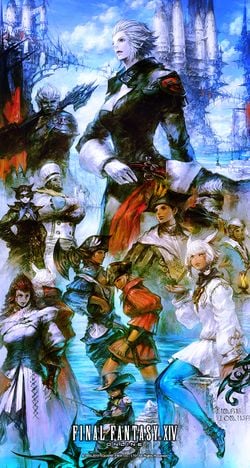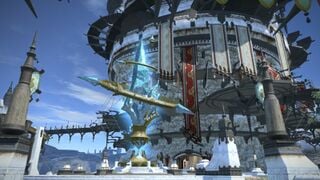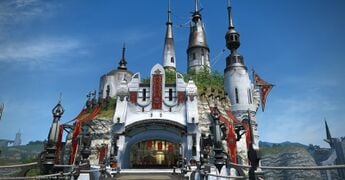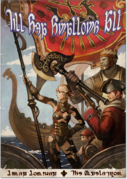Limsa Lominsa
Limsa Lominsa
- Type
- City
- Zone
- La Noscea
(Vylbrand) - Aetherytes
- Limsa Lominsa Lower Decks (X:9.4, Y:11.2)
“"Till Sea Swallows All."
On the southern coast of the island of Vylbrand, under the shadow of ancient cliffs worn by the relentless onslaught of the Rhotano Sea, lies the maritime city-state of Limsa Lominsa. Said to be blessed by the goddess of navigation, Llymlaen, the city is spread out over countless tiny islands, pillars of rock and reef that jut out from the bay, each connected by long, sturdy bridges of iron and wood construction, earning her the name the "Navigator's Veil" from traveling bards who have witnessed the city's beauty from afar.— In-game description
Limsa Lominsa is a city in La Noscea.
General Information
“On the southern coast of the island of Vylbrand, under the shadow of ancient cliffs worn by the relentless onslaught of the Rhotano Sea, lies the marine city-state of Limsa Lominsa. Said to be blessed by the goddess of navigation, Llymlaen, the city is spread out over countless tiny islands, each connected by sturdy bridges of iron and wood construction, earning her the name the "Navigator's Veil" from traveling bards who have witnessed the city's beauty from afar.
Limsa Lominsa is a traditional thalassocracy, with power lying in the hands of the ruling party and its leader, the Admiral. Its economy is driven by shipbuilding, fishing, and blacksmithing, but the majority of wealth comes from the lucrative shipping industry.
To maintain the safety of its maritime routes, the city employs a formidable navy known as the Knights of the Barracuda. However, even in the waters nearby the city, pirate bands run rampant, reaving and pillaging.— Game Description
Limsa Lominsa is one of the starting cities in Eorzea. The maritime city-state of Limsa Lominsa, located on the southern coast of the island of Vylbrand, is built within and across steep, white rocks and reefs within Galadion Bay. It is the largest and most famous port in the realm, and has a long history of nautical trade and piracy. Merchants from all over come to ply their wares in Limsa Lominsa, be they from across the Rhotano Sea on the continent of Aldenard or as distant as The New World to the west of the Three Great Continents.
Limsa Lominsa Sidequests
Guilds
Limsa Lominsa has the following Guilds:
- Marauders' Guild
- Arcanists' Guild
- Rogues' Guild
- Blacksmiths' Guild
- Armorers' Guild
- Culinarians' Guild
- Fishermen's Guild
Zones
Limsa Lominsa consists of two zones, the Lower Decks and the Upper Decks. Teleporting into Limsa Lominsa places you at the main Aetheryte, on the Lower Decks.
Limsa Lominsa Upper Decks
- Main article: Limsa Lominsa Upper Decks
Limsa Lominsa Lower Decks
- Main article: Limsa Lominsa Lower Decks
Mist
- Main article: Mist
Lore
Vylbrand rises from the waves of the Rhotano Sea, and beneath the worn and ancient cliffs on its south shore stands the maritime city-state of Limsa Lominsa. A beautiful and wondrous sight, the city perches upon pillars of rock and reef that jut out from the bay. Townsfolk pass between these areas on long bridges, and so thrive above the seas.
Flag
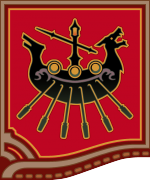
The obsidian longboat upon Limsa Lominsa's standard is a pirate ship, and hearkens back to the founders of the city: brutal Sea Wolf buccaneers, once the terror of the north seas. It should come as no surprise, then, that the crimson field represents the spilled blood of lost companions, and reflects the city-state's savage and gruesome history.[1]
Motto
Til Sea Swallows All
Government
Lominsans choose their leader in the Trident, a competition held once every seven years. The strongest of pirate crews run this multi-pronged race, and whosoever crosses the finish line first becomes admiral, the head of the maritime city-state. Afforded sweeping powers over Limsa Lominsa, new admirals will often drastically alter existing policies—and with it, change the course of the city-state.[1]
Leader
Ruling Body
A number of councilors, nominated personally by the admiral, oversee the everyday proceedings of the thalassocracy.[1]
Racial Distribution
Sea Wolf Roegadyn: 40%
Miqo'te Seekers of the Sun: 20%
Plainsfolk Lalafell: 20%
Midlander Hyur: 10%
Other: 10%
Religion
As one might expect for a maritime city-state, Lominsans revere Llymlaen, watcher of the seas and goddess of navigation. True believers make pilgrimages to the mark of the Navigator before they set sail, and upon their safe return to port. The worship of Lymlaen has roots in a loose collection of local beliefs, however, and thus cannot be thought of as a formal religion. Indeed, the Navigator has no grand temples nor clergy to Her name in Limsa, save the odd bethel overlooking the endless seas. Instead, each man keeps his own faith within his home through prayer and humble ritual.[1]
Industries
Piracy
In the present day, piracy as such is forbidden. Privateering, on the other hand, is permitted, provided that the plunder be of Garlean origin.[1]
Fishing
Lominsan anglers come together in numerous loose associations of "pullers" and eke out their living by casting off the coastal cliffs and trawling the open seas.[1]
Shipbuilding
Whether they be crafting great warships or fishing skiffs, the shipwrights of Limsa Lominsa have no equals within the realm—as they themselves will proudly proclaim.[1]
Metalwork
The art of steel-making evolved alongside the shipbuilding industry and has profited much from Lominsan exchanges with the kobolds who are masters of metallurgy in their own right.[1]
Shipping
With their considerable knowledge of shipbuilding and seafaring, it was natural that a shipping industry should flourish in the city-state. Many and more are trading vessels that can be seen sailing in and out of port each day.[1]
Farming
A settlement initiative has made great strides in providing an honest livelihood for those retired from freebooting, who grow mainly oranges, grapes, and wheat.[1]
Beliefs
Founded by men fleeing the rules of kings, Lominsans continue to see laws more as guidelines than actual rules. Whether pirate or fisherman, citizens generally feel less loyal to their city-state than to their immediate crew. This spirit of freedom ever drives Limsa forward, yet the selfsame wild abandon may appear brutish in the eyes of other Eorzean nations.[1]
Diet
Naturally, Lominsan cuisine makes use of the abundant fresh fish and shellfish. The city-state is a favorite of gourmands, as the seafaring culture brings foreign spices and recipes aplenty to the table. Likewise, Lominsan liquors, which were developed to keep on long sea voyages, are famed—particularly the ales and wines, brewed from local wheat and grapes in great quantity.[1]
Bonus
Though Merlwyb has spent most of her forty-two years joyfully upon the seas, she can scarcely afford to sail the waves as Admiral. Instead, she indulges her second passion-fine wines. It is said her particular favorite is a deep chalice of Lohmani red.
History
The Founding of a City
In 874 of the Sixth Astral Era, the Galadion set sail from the isles deep in the northern seas—the last of a mighty armada which turned on its nation in the name of the people, only to meet defeat at the hands of those they meant to free. The Sea Wolf crew of this noble vessel, who could no longer abide the rule of tyrants, steered her crippled hull south through unknown waters in search of a new home. After a yearlong voyage cursed by many troubles, the ship drifted to the southern coast of Vylbrand, and there ran aground.
The Galadion carried two Elezen helmsmen: Jean De Nevelle, a navigator, and the adventurer Guy La Thagran. Tasked with exploring the interior of the island, both confirmed that the region was fertile. In this land, the crew realized that they had found the home they had sought. Under Admiral Elilwaen, leader of the expedition, the crew built a small village inland of what was soon dubbed La Noscea after a second lodesman who perished of scurvy just two days before landfall.
However, it quickly became clear that the men and women of the Galadion were not alone, and had trespassed upon the domain of the kobolds, a tribe of badger-like beastmen. After a few skirmishes, the crew abandoned their village for the relative safety of the Galadion, which they had left stranded upon the La Noscean coast. From their ship, they built bridges to the small islands and exposed reefs scattered about the bay, and thus the maritime city-state of Limsa Lominsa was born.
A Maritime Age
Limsa Lominsa in its early days was a place for coinless refugees. Unable to make full use of La Noscea’s rich resources due to the continued hostility of the kobolds, the Lominsans lived in poverty, much as they had in the north seas. They kept their skills as sailors, however, and thus chose the path of survival open to them—piracy.
After occupying the few scant forests of lower La Noscea and gaining a source of lumber, the Lominsans set about building warships. With the salt-heavy winds at their back, the early townsfolk came into their element, and began to attack the merchant ships sailing the Rhotano Sea—ferocious as wolves preying upon sheep. Soon, the city-state was rich with plunder, and a black market had opened to peddle the stolen goods.
Thus, it was through piracy that Limsa Lominsa’s population grew larger and more diverse. Plainsfolk came from the south sea isles, drawn by rumors of cheap wares, and Lominsan pirates oft gave members of captured crews the choice to join their ranks. Before long, Sea Wolves worked the docks of the maritime city-state alongside Seekers of the Sun and Hyur.
The Trident
As the pirates grew in number, they began to organize into proper crews. As the number of crews multiplied, however, quarrels among them became more common. Questions of territory and shares of plunder erupted into violence in the 940th year of the Sixth Astral Era, and for nearly two decades thereafter, the streets ran with the blood of feuding pirates. The madness continued until 963—the year that Agatzahr Roehmerlsyn assumed the admiralship.
From a buccaneer background himself, Admiral Agatzahr invited the strongest of the warring crews to the negotiation table. Through bartering and threats, he secured their solemn oath to put an end to the fighting. More miraculously, however, he put forth a code of conduct which every corsair would have to honor: No crew would cheat another of its plunder, nor rob a fellow Lominsan, nor sell fellow men into slavery.
Though the code itself was revolutionary, its enforcement was perhaps more so. The best of all crews came together and founded the Upright Thieves, a shadowy organization that punished those who broke the code. Admiral Agatzahr’s rules became as law to the pirates not because they were imposed from above, but rather because they were enforced in every back alley and bad tavern. Thanks to this, peace returned to Limsa.
Agatzahr went on to tax the revived trade in plunder, and used the proceeds to bolster the Knights of the Barracuda, the Lominsan navy. With this force, he devoted himself to fighting the kobolds. Through Agatzahr’s reforms, Limsa Lominsa became mighty: the pirates grew wealthy from raiding foreign vessels, while the Barracudas secured the interior territories and defended the harbor. In his late years, the Admiral also established the Trident so as to avoid a war of succession. Truly, the maritime city-state would not be the power it is today without his many contributions.
Revolution
For several hundred years, the Trident reliably produced leaders who served seven years—though history is littered with admirals who stayed in office for longer. Many pirate lords rose to the position, and their strength allowed them to rein in the rough seafaring citizens. In this way, Limsa Lominsa maintained unity as a city-state.
However, the Trident was to produce a leader in 1563 who would change the maritime city-state in greater ways than ever before: Merlwyb Bloefhiswyn. Though she herself was a pirate leader of the infamous League of Lost Bastards, Merlwyb declared piracy illegal upon assuming the admiralship—an act that shocked Lominsans and dealt a blow to the mainstay of its economy. Why would she do such a thing? Evidently, the Admiral realized that Limsa could not face the encroaching threat of the Garlean Empire without powerful allies, and could ill afford to antagonize the other nations of Eorzea.
The Galadion Accord
Naturally, the Admiral’s order outlawing piracy was unpopular amongst the heretofore state-sanctioned corsairs, and more than a few daring attempts were made on Merlwyb’s life. However, her will was of steel, and she refused to budge by even one ilm. She won what crews she could through negotiation, persuading them of Limsa’s need to cooperate with the other city-states. And the crews who remained unyielding, she silenced.
Merlwyb showed her strength as a leader in other ways as well, particularly in deftly dispelling the primal threat that came to hang over the city-state. In 1565, she allocated state funds towards the hiring of the Company of Heroes, a famed mercenary band. This proved coin well spent as when the kobolds summoned Titan a year later, the sellswords were there to vanquish the aetherial deity. In the same year, they worked alongside the Knights of the Barracuda to fell Leviathan when the Sahagin called their own primal unto the realm.
Seeing both the Lord of Crags and the Lord of the Whorl defeated through the Admiral’s foresight, many Lominsans warmed to Merlwyb, and soon those voices that decried her were singing her praises. By 1572, she was able to establish the Maelstrom, Limsa’s Grand Company. Her final victory was the Galadion Accord, which bound the pirate crews to the Maelstrom, and unified all of Limsa Lominsa under her command. [2]
Notes and Trivia
- The demonym for people or things from Limsa Lominsa is "Lominsan."

